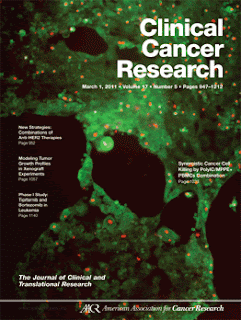martes, 15 de marzo de 2011
Bayesian Hierarchical Changepoint Methods in Modeling the Tumor Growth Profiles in Xenograft Experiments — Clin Cancer Res
Bayesian Hierarchical Changepoint Methods in Modeling the Tumor Growth Profiles in Xenograft Experiments
Lili Zhao1, Meredith A. Morgan2, Leslie A. Parsels3, Jonathan Maybaum3, Theodore S. Lawrence2, and Daniel Normolle4
+ Author Affiliations
Authors' Affiliations:1Biostatistics Unit, University of Michigan Comprehensive Cancer Center; Departments of 2Radiation Oncology and 3Pharmacology, University of Michigan Medical School, Ann Arbor, Michigan; and 4Biostatistics Facility, University of Pittsburgh Cancer Institute, Pittsburgh, Pennsylvania
Corresponding Author:
Lili Zhao, Biostatistics Unit, University of Michigan Comprehensive Cancer Center, 1500 East Medical Center Drive, Ann Arbor, MI 48109. Phone: 7347636898; Fax: 7349364540. E-mail: zhaolili@umich.edu
Abstract
Purpose: The standard approach of using tumor doubling time to assess growth delay may not accurately represent tumor response, especially if the growth rates are not constant. Therefore, we developed a method to compare the antitumor activities of different treatments in xenograft experiments that uses the entire growth curve to estimate nonconstant growth rates.
Experimental Design: A Bayesian hierarchical changepoint (BHC) method was used to model logarithmically transformed tumor volumes (TV). Each tumor was assumed to have a growth profile, represented by a prenadir regression rate, a regression period, a nadir volume, and a postnadir regrowth rate. Confidence intervals were calculated to compare these features between different treatments. We used data from a study assessing the effects of radiation, gemcitabine, and a Chk1/2 inhibitor on MiaPaCa-2 xenografts.
Results: We found that the BHC model provided a good fit to the data and more descriptive features than the tumor doubling approach. This model detected significant tumor regression in the AZD7762 + 1 Gy and GEM + 1 Gy that was not detected when comparing the tumor doubling times. The BHC model also provided evidence that the growth inhibition resulted from a direct tumor effect rather than an indirect effect on the tumor bed, as evidenced by dramatic tumor regression in response to effective treatments and similar postnadir regrowth rates across all treatment groups.
Conclusions: Compared with the tumor doubling time approach, the BHC model utilizes all data, providing more descriptive features that address mechanisms underlying tumor growth inhibition and maximize the biological information obtained from tumor xenografts studies. Clin Cancer Res; 17(5); 1057–64. ©2010 AACR.
See commentary p. 949
Received July 21, 2010.
Revision received November 9, 2010.
Accepted November 25, 2010.
©2010 American Association for Cancer Research.
Bayesian Hierarchical Changepoint Methods in Modeling the Tumor Growth Profiles in Xenograft Experiments — Clin Cancer Res
Suscribirse a:
Enviar comentarios (Atom)






















.jpg)












No hay comentarios:
Publicar un comentario